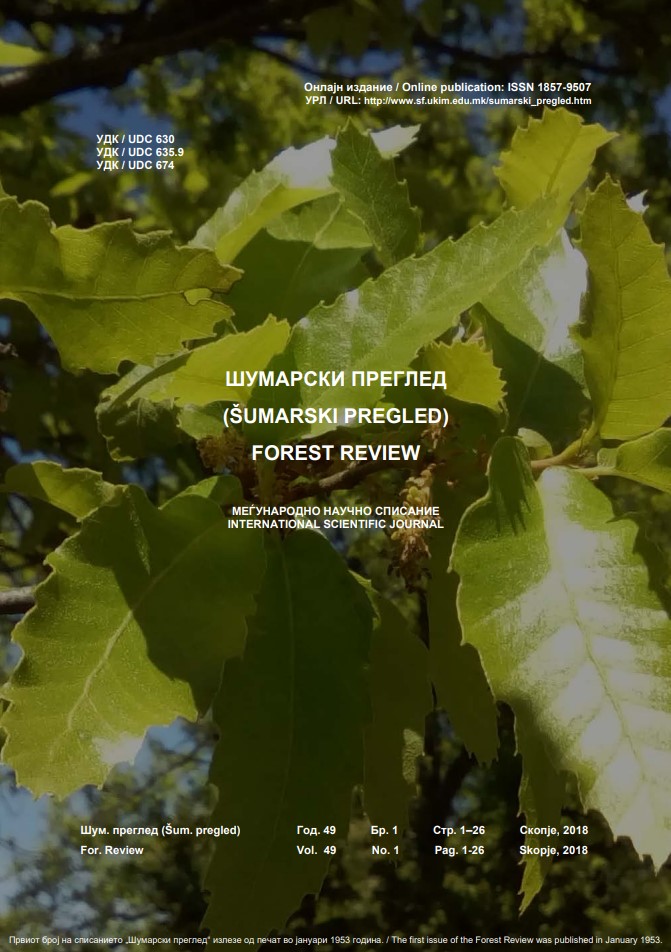Шумарски преглед, год. 49, бр. 1
Forest Review, Vol. 49, No. 1
Issue Articles
Comparative analysis for the exposure of workers to vibrations in forestry and agriculture
Authors: Todi Gochevski, Boris Krstev
⇑ DOI:
Original scientific article
Abstract:
Healthy and safe working conditions are prerequisites for sustainable management of forest and agriculture workers. In practice sustainability can only be ensured by properly instructed and trained workers doing a good job. Long term exposure to either hand-arm or whole-body vibration has been associated with the development of certain musculoskeletal disorders. Many sawmill employees are exposed to vibration on a daily basis. This paper aims to analyze data for safety and protection of workers in forestry and agriculture professions who are exposed on negative effects caused by mechanical vibrations. For reaching this aim, a questionnaire with 8 questions and 34 offered answers was prepared. The survey was conducted randomly and we had 386 respondents from 500 calls. The contacted people who refused to respond were not taken as a parameter in any analysis. Several cities from north, central, south, east and west region of Macedonia were points of interest. The people were contacted telephonically by National phone network of home phone numbers. The results from workers in forestry and agriculture professions were separate in four segments: determination of exposure on vibration by professions, determination the amount of vibrations by systems of transsmiting on workers, daily exposure to vibration A(8) and implemented vibration control measures. In forestry professions we have the biggest percent of workers who are working with powered hand tool followed from the workers who operate special forestry vehicle and the least are workers that working with non-powered tools. When we are talking about how the vibrations are transmitted, professional workers with hand held operating tool are most exposed on vibration system called hand-arm vibration (HAV), the opposite of the workers who are managing forestry vehicles that are mostly exposed to the whole body vibrations. In daily exposure on vibrations A(8) hand tool operators are exposed in a smaller amount of time to vibrations in contrast of workers who operate forestry vehicles. This trend was also followed in the agriculture professions. In implemented control vibration measures in agriculture all segments had very high percentage of positive responses, while in the forestry companies executives need to work on providing trainings for prevention and purchasing new products that produces less vibrations.
Keywords: hand-arm vibrations, control vibration measures, daily exposure A(8), forestry and agriculture
Detecting alternative prey of the Balkan lynx using scat analysis
Authors: Gjorge Ivanov, Dime Melovski, Robert Janevski, Aleksandar Stojanov, Vasko Avukatov, Aleksandar Pavlov
⇑ DOI:
Original scientific article
Abstract:
The Eurasian lynx (Lynx lynx L. 1758) is an ambush predator with preference for medium-sized ungulates. The felid, however, has a varied diet which includes other animals, ranging from lagomorphs and rodents to chiropterans and small carnivores. The paper offers an overview of the alternative diet of the endangered population of the Balkan subspecies (Lynx lynx subsp. balcanicus) in western Macedonia. Alternative prey detection was done by analysing scat material collected near feeding site or found by chance in the period between 2010 and 2018. A total of 37 scats were retrieved. Of the total scats brought for analysis, only 28 gave conclusive results. Scat samples were analysed for morphological characteristics, undigested parts of the prey item (hairs and bones), also including immunological and serological analysis of the immunoglobulins present. Data reveals a diverse assortment of animal prey species with roe deer, chamois, brown hare, marten, wild boar, rat, mouse, red squirrel, edible dormouse, shrew, and pipistrelle bat. Such dietary shift in this predator may be owning to the unavailability of its principal prey item, namely roe deer, but also chamois. Therefore, anthropogenic pressure on the main prey species presents significant threat to ensuring a healthy and viable Balkan lynx population.
Keywords: Balkan lynx, alternative prey, scats, immunoglobulins, hairs
Use of modern geomatic techniques for creating and updating a green cadastre of urban trees and shrubs: a case study of Kumanovo city river bank
Authors: Bojan Mihajlovski, Ivan Minchev, Ivan Blinkov, Bojan Simovski
⇑ DOI:
Original scientific article
Abstract:
The goal of this paper is to implement modern, up-to-date, geomatics technique and technologies in the environment. The base is made in GIS software, a GPS device is used to record detailed points on the field and for recording and preparing a new orthophoto was used a modern sophisticated drone DJI Mavic Pro. QGIS (Quantum Geographic Information System), as a key software, was used for computer data processing and recordings obtained from the field research, and other utility programs were used to perform the tasks. The subject of the article is the Kumanovo city promenade in Macedonia, which is a convenient place to try to implement this data processing method. The results obtained give us a map of the entire urban dendroflora on the river bank in the city of Kumanovo. In fact, an inventory of all trees and shrubs was carried out, 4 projections were prepared with the help of modern applications, and as the ultimate goal, and a web digital map of the riverbank was prepared. This method can be applied in forestry, agriculture, water management, geodesy, space planning, sustainable development and environmental protection.
Keywords: QGIS and GPS, drone, urban dendroflora inventory, geomatic techniques, remote sensing, Kumanovo
Forests’ health in Maleshevo region
Authors: Blagoj Shurbevski, Sterja Nacheski, Irena Papazova-Anakieva
⇑ DOI:
Original scientific article
Abstract:
The aim of this research was to assess the current health condition of the forests in the Maleshevo region, to examine the influence of different factors and if possible, to identify future threats to the health of the forests. The main focus of research were insect pests, as the most common negative influence in the forests of this region recorded in recent past. The research was done by collecting data and its analysis on six square – shaped sample plots with surface area of 625 m2 each. The research was done in the course of five months, from July to November 2018. Samples were also taken to the entomological laboratory of the Faculty of Forestry in Skopje for further analysis. The presented results show the qualitative and quantitative states of each of the noted factors that influence the health of the forest. The number of determined species of insect pests was 13, of which the most influential are the bark beetles and the pine processionary moth. However, if the abundance of these species is compared to the research done in 2003 and in 2009 respectively, the situation can be considered as improved. Based on these results, recommended measures are also given in order to improve the level of forests’ health in this region.
Keywords: forests’ health, Maleshevo, pests, bark beetles, sample plots, wood samples




